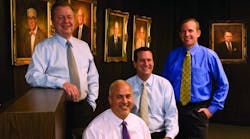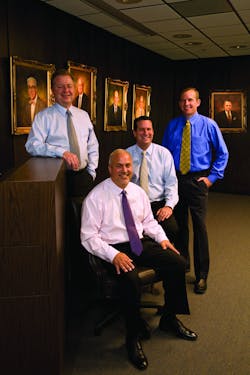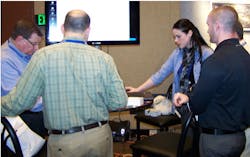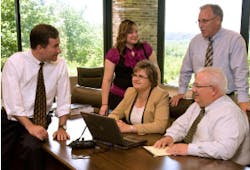Sponsored
Crescent Electric Supply Profile: Orchestrating Change
When you visit Crescent Electric Supply’s headquarters in East Dubuque, Ill., you get a strong sense of the company’s past, present and future. Nestled atop a bluff overlooking the Mississippi River, you get a great view of the busy riverfront of Dubuque, Ill., its classic red-brick buildings and docks. Without too much imagination, you can see what the city of 58,000 might have looked like in the 1800s, when steamboats and barges plied their trade on the river below and the Mississippi was one of the key corridors of commerce as the United States expanded westward.
Once you step inside Crescent’s headquarters, you immediately get a sense of the company’s history and of the importance it places on its employees and the relationships it has established over the years with customers and vendors. Along the walls are mementos such as supplier awards, photos of fishing trips, golf outings and other customer events from years gone by.
As you walk past these mementos toward the offices of the executive team that manages Crescent Electric for the Schmid family of owners, you realize how much the past is woven into the very fabric of the company. And after spending some time with Marty Burbridge, the company’s president and CEO, you realize just how hard he and his management team are working to blend the culture of a family-owned business with an intense focus on customer service and flexibility in the marketplace with some of the latest thinking on sales and marketing and e-commerce strategies; a new Eclipse ERP system; a broad initiative into the green market; a Tour de Force CRM (customer relationship management) system; a customized learning management system (LMS); and an annual sales training conference that this year attracted 380 of its outside salespeople and personnel from 53 of its key suppliers.
Crescent Electric’s executive team believes the multi-million dollar investment they have made in these strategic initiatives will push the company well past the $1 billion in annual sales it logged in 2012 as one of the 10 largest distributors of electrical supplies in the United States. It’s interesting that even though the company has made some monumental investments in cutting-edging technology, training, acquisitions and personnel, the basic growth mantra that will determine its success in the future is one that Titus Schmid would have been very familiar with 90 years ago: stay flexible and stock what customers need where and when they need it.
With all of these initiatives underway, EW’s editors thought it would be good time to learn what’s happening at Crescent Electric. In the past the company shied away from the spotlight, but today’s management team is very proud of what Crescent has accomplished and was glad to chat about their future plans.
Orchestrating all of the company’s strategic growth initiatives is Marty Burbridge, who like Titus Schmid had a background in the construction business before coming to Crescent Electric more than 30 years ago. Burbridge likes to joke that change was pretty gradual for Crescent Electric for the first 30 years he was with the business, but says that for the past five-to-seven years, “It has gone from a trot to a sprint.” He says the Schmid family owners approve the management team’s major investments in the business, but rely on the company’s professional board of directors and management executives with decades of experience in the electrical market to drive growth. Burbridge and the other senior executives run the company as a family-owned business with an almost national footprint that doesn’t fixate on quarter-to-quarter profits.
In many ways, Crescent Electric’s annual sales conference neatly defines the company’s core operating strategies of giving employees the training and resources to do their jobs at the local level, but at the same time taking advantage of the company’s collective resources on a centralized basis when it makes sense. In scope and intent, the sales conference is truly massive and because of its sheer size, the event may very well be unique in the industry.
For the past decade, the company has invested in the not inconsequential cost of transporting all of its field salespeople and inside salespeople to a four-day national sales conference and training event and trade show. The field salespeople and inside salespeople attend on alternating years. When it’s the inside salespeople’s turn, Crescent Electric Supply runs two separate events so each branch location will still have inside sales personnel on hand while the others are being trained in the Chicago area.
This year’s event was held in March 10-14 at the Q Center in St. Charles, Ill., where the company gathered 380 of its outside salespeople and personnel from 53 of its key suppliers for several days of intensive product and sales training and nightly trade shows held by the electrical manufacturers that did the training seminars during the day.
Christopher Breslin, the company’s senior V.P. and COO, said Crescent Electric invests in the annual training event because it’s a competitive advantage. “We have been doing this for many years in good economies and even more in turbulent times,” he said. “We ask our sales team to take four days and dedicate themselves solely to training and self improvement. Three days are dedicated to supplier training and one day to sales skills and how to use our available tools and resources.”
The event has proved very popular in the electrical manufacturing community — Breslin says there’s a waiting list for suppliers who want to present in the seminar sessions or exhibit at the trade show. During this year’s event, named “Sales Revolution,” attendees were trained on uniform sales management processes to use the CRM system most effectively. In addition to the scheduled training events, Crescent Electric Supply sales personnel had ample time to network with their peers from well over 100 branches across the United States.
“You have all the new segment stuff — datacom, automation, lighting, energy,” he says. “Then on top of that you add in, ‘How do you use CRM? ‘How do you change to a new operating system?’ We have chosen to take 80% of that and consolidate it, so when an employee shows up at their every-other-year conference, they know they will get training on products they have probably never trained on. The training is application-based, not features-based. At the trade show there are specific people who can help them close orders at specific customers on specific applications. The training is specific and germane to each attendee, and two people from a branch might be going to different classes. We give them electives, too.”
Kathy Klein, the company’s training coordinator, works with the suppliers at the conference to ensure the content of their seminars is on target with the attendees’ information needs. From the feedback she has gotten from past events, Klein knows salespeople want presenters who can offer tips on how and where to sell a product, and that they don’t want to sit through a 45-minute PowerPoint presentation with a product engineer just reading off bulleted points on product features.
In addition to putting together the curriculum at the annual conference, Klein, who had a career as a teacher before coming to the company, manages the rest of Crescent Electric Supply’s training efforts, too. She uses a blended training approach that incorporates instructor-led classes, webinars, self-study, manufacturer seminars at local branches and the company’s new learning management system (LMS). Which approach she uses all depends on the audience and subject matter.
“When I started in education, all you needed was a piece of chalk,” she says. “Now there almost infinite possibilities in how you deliver training. A big part of my job is seeing what makes sense at the conference, what makes sense via webinar, what makes sense with online interactive modules, lunch-and-learns, factory training and cheat sheets. Blended learning is all over the place. We collaborate with the suppliers to figure out what’s the best way to do any of that.”
In addition to coordinating training for the rollout of the Tour de Force CRM, she worked with the Eclipse team to decide how to roll out training for that implementation. They had to decide which training should be online, what’s instructor led, what is on-the-job training and what other resources could be used.
She incorporates IMARK University and some of the NAED training modules for Crescent Electric’s online training and says the company produces its own webinars in some cases and teams up with suppliers for others. When developing her own training materials, Klein uses Articulate Storyline for courses that will be placed on the LMS system and Citrix GotoWebinars for webinars. She tries to keep the webinars to 30 minutes. “What’s fun for me is that there is an expectation that there will be a webinar and that it will be recorded,” she says. “Back when we started, there were not expectations. We learned as we went.”
She says some subjects work well online but that some content should be delivered in-person. For example, Klein says classes on listening skills and customer service should be in person, and that product training works best when students can touch and feel the product. “There is only so much you can do with a picture or video,” she says.
She says that another point in favor of in-person events like the Sales Revolution conference is the incidental learning that takes place outside the classroom. “At the conference, it’s learning from one another, too … the networking. That doesn’t happen with large webinars.”
Klein also has to tailor training to different age groups. Sometimes that means being aware of who’s comfortable with using certain types of training, and other times it means making the training a bit shorter and more immediate for a younger audience that might not have quite as long of an attention span. “I am a great believer in using all of the technologies that are available, but not abandoning anything that works,” she says.
United they stand
One of the common themes running throughout the strategic initiatives currently underway at Crescent Electric is to stay nimble in the local markets by empowering branch managers and account managers to make decisions, but to implement centralized business systems and processes where they make sense. Once such system is Crescent’s investment in the Tour de Force CRM system, which will allow the company to manage its sales pipeline. Before implementing Tour de Force, Bob Settle, the company’s V.P. of marketing, said the sales force managed contact information with a variety of different methods. “Every account manager had their system,” he said. “Many of them used Outlook, or another contact management program and some used Daytimers or business card files. We had these contacts in different locations and none of them were centralized, so keeping a mail list up to date was difficult.
“And from an account management standpoint, every account manager had their own system, all disconnected and individualized as well. We were really looking for a system that would allow us to have a single point of contact and a single location for all customer data, such as contact information, activities and e-mail addresses.”
They found a solution in Tour de Force, a CRM system developed by a former Rockwell Automation distributor. The system gives account managers daily reports on account sales and profitability data, open orders, open quotes and other customer data. The salespeople did not previously have access to this amount of customer data on a timely basis, and this was a big selling point for the CRM system.
Settle says part of the training on the system was helping salespeople understand “What’s In It for Me”
(WIIFM). While some account managers were a little hesitant to let go of “their” account data and input account information into Tour de Force’s centralized contact management system, a series of webinars developed by Randi Trumm, the company’s CRM administrator, helped smooth the transition.
From a management perspective, Settle says Tour de Force helps the company track opportunities, forecast sales, fine-tune marketing and sales initiatives and track leads to sales with the help of the company’s lead generation group. This department uses Tour de Force to qualify new sales prospects and to set up appointments for account managers in the field. Settle says his department will first pull a prospect list for a specified market segment from a Dun & Bradstreet or Hoovers database, scrub it to remove existing customers, and upload it into Tour de Force so the lead generation group can qualify potential leads.
The fact that Tour de Force was developed by an electrical distributor was a big reason Crescent Electric went with the Tour de Force CRM system. Another key reason, says Settle, is that it’s designed to tie into the Eclipse ERP system, which the company is implementing. Burbridge says switching over to Eclipse is a major undertaking for a company of Crescent Electric’s size. “Eclipse is supported by 50% of the industry,” he says. “I think we will be well-served by their experience.”
Down the road
As the company incorporates these initiatives into its operations, it’s also assessing new acquisitions or branch start-ups. Over the past two years Crescent has made three major acquisitions (McCullough Electric Co., Pittsburgh; Stoneway Electric Supply, Spokane, Wash.; and Lake Electric Supply, Storm Lake, Iowa.) It also purchased three branches of Broken Arrow Electric Supply in Lee’s Summit, Warrensburg and Warsaw, Mo., and opened new branches in Pinetop-Lakeside, Ariz., and Sidney, Mont.
Burbridge says the company is looking at acquisitions that are both geographically- and segment-driven. He says timing is everything in acquisitions, “Just like everything else at Crescent, our acquisition strategy is quite flexible,” he says. “We’re built to act quickly. We can have an evaluation in 24 to 48 hours.
“That’s one of the good things about being Crescent. We are a privately held by a family that invests a significant amount of the company’s income back into the business and allows a professional team of managers to run the business for them. This company would make a really good business school case study.”







